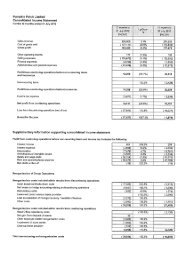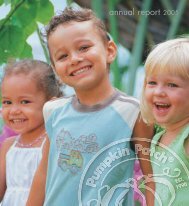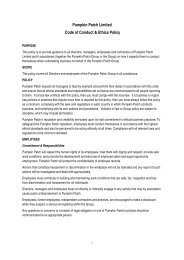annual report - Pumpkin Patch investor relations
annual report - Pumpkin Patch investor relations
annual report - Pumpkin Patch investor relations
You also want an ePaper? Increase the reach of your titles
YUMPU automatically turns print PDFs into web optimized ePapers that Google loves.
PUMPKIN PATCH LIMITED & SUBSIDIARIES NOTES TO THE FINANCIAL STATEMENTS 31 JULY 2010<br />
PUMPKIN PATCH LIMITED & SUBSIDIARIES NOTES TO THE FINANCIAL STATEMENTS 31 JULY 2010<br />
25 FINANCIAL RISK MANAGEMENT<br />
The GroupÕs activities expose it to a variety of financial risks: market risk (including currency<br />
risk and interest rate risk), credit risk and liquidity risk. The GroupÕs overall risk management<br />
programme focuses on the unpredictability of financial markets and seeks to minimise<br />
potential adverse effects on the financial performance of the Group. The Group uses<br />
derivative financial instruments such as foreign exchange contracts and options and interest<br />
rate swaps to manage certain risk exposures. Derivatives are exclusively used for economic<br />
hedging purposes (ie not as trading or other speculative instruments), however not all<br />
derivative financial instruments qualify for hedge accounting.<br />
Risk management is carried out based on policies approved by the Board of Directors. The<br />
Group treasury policy provides written principles for overall risk management, as well as<br />
policies covering specific areas, such as foreign exchange risk. The Parent is not directly<br />
exposed to any significant financial risk.<br />
(iii) Summarised sensitivity analysis<br />
The following table summarises the sensitivity of the GroupÕs financial assets and financial<br />
liabilities to interest rate risk and foreign exchange risk.<br />
A sensitivity of 10% for foreign exchange risk has been selected. Despite the recent volatility<br />
in the currency markets over the past 12 months, an overall sensitivity of 10% is considered<br />
to be reasonable based upon the exchange rate volatility observed on a historic basis for<br />
the preceding five year period and market expectation for potential future movements.<br />
A sensitivity of 1% has been selected for interest rate risk. The 1% sensitivity is based on<br />
reasonably possible changes over a financial year, using the observed range of historical<br />
data for the preceding five year period.<br />
Amounts are shown net of income tax. All variables other than applicable interest rates and<br />
exchange rates are held constant.<br />
(A) MARKET RISK<br />
(i) Foreign exchange risk<br />
The Group operates internationally and is exposed to foreign exchange risk arising from<br />
various currency exposures, primarily with respect to the United States dollar, the British<br />
pound and Australian dollar.<br />
The purpose of the GroupÕs foreign currency risk management activities is to protect the<br />
Group from exchange rate volatility with respect to the New Zealand dollar net cash<br />
movements resulting from the sale of products in foreign currencies to foreign customers and<br />
the purchase of products and raw materials in foreign currencies from foreign suppliers.<br />
The Group enters into foreign currency option contracts and forward foreign currency<br />
contracts within policy parameters to manage risk associated with anticipated sales or<br />
costs denominated principally in United States dollars, British pounds and the Australian<br />
dollar. The terms of the foreign currency option contracts and the forward foreign currency<br />
contracts do not exceed three years. These anticipated sales or costs qualify as highly<br />
probable forecasts for hedge accounting purposes.<br />
Refer to note 10 which shows the forward foreign exchange contracts and options held<br />
by the Group as derivative financial instruments at balance date. A sensitivity analysis of<br />
foreign exchange rate risk on the GroupÕs financial assets and liabilities is provided in the<br />
table below.<br />
(ii) Cash flow and fair value interest rate risk<br />
The GroupÕs main interest rate risk arises from floating rate borrowings drawn down under<br />
bank debt facilities. When deemed appropriate, the Group manages floating interest rate<br />
risk by using floating to fixed interest rate swaps. Interest rate swaps have the economic<br />
effect of converting borrowings from floating to fixed rates.<br />
Refer to note 10 for notional principal amounts and valuations of interest rate swaps<br />
outstanding at balance date. A sensitivity analysis of interest rate risk on the GroupÕs<br />
financial assets and liabilities is provided in the table below. Refer to Note 16 for further<br />
details of the GroupÕs borrowings.<br />
20<br />
years<br />
young<br />
87












